R
Richard Dredge
Guest
Volkswagen has come a very long way since the launch of the Beetle in the 1940s. The firm’s first model really was a people’s car; it was very accessible and the focus was on utility and low running costs.
In the intervening years things changed somewhat, reaching their zenith with the Phaeton’s introduction in 2002, although sales were slower than VW wanted.
The company’s ambitions shrank a little after that with the introduction of the Passat-based CC saloon, which in 2017 was superseded by the more practical Arteon hatchback. This struck a neat balance between practicality, luxury and affordability.
Models covered
The Arteon hit UK roads in September 2017, priced from £34,305 and with a choice of 187bhp 2.0 TSI petrol or 2.0 TDI diesel engines. The latter came in 148bhp and 237bhp forms, the more powerful only with 4Motion (four-wheel drive) and DSG.
A 148bhp 1.5 TSI arrived three months later, then a 268bhp 2.0 TSI was added in December 2018, in DSG guise only.
Only a five-door hatchback body was offered and buyers could choose Elegance or R-Line trims; an SE was added in July 2019.
The Arteon range was expanded in October 2020 when a Shooting Brake (estate) body joined the hatchback, and at the same time the SE trim level became SE Nav. Just a few months later in January 2021 a plug-in hybrid joined the line-up.
There are no poor engine or transmission choices when buying an Arteon; all of them offer a decent balance of performance, refinement and economy. Everyday running costs for the 2.0 TSI are higher thanks to its greater thirst, but that’s the trade-off for having stronger performance.
All Arteons are generously equipped, with the entry-level SE featuring 18-inch alloy wheels, LED headlights, privacy glass, an eight-inch touchscreen with navigation, DAB radio, adaptive cruise control, three-zone climate control, automatic headlights and wipers, plus a heated windscreen along with front and rear parking sensors.
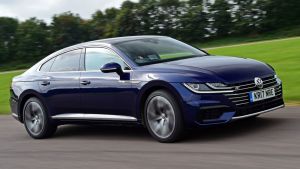
Used Volkswagen Arteon - front tracking
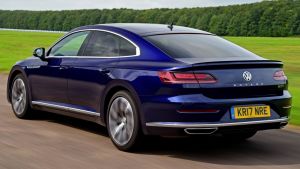
Used Volkswagen Arteon - rear tracking
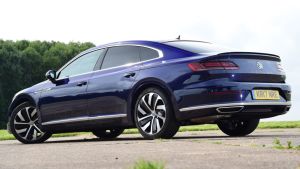
Used Volkswagen Arteon - rear

Used Volkswagen Arteon - front lights
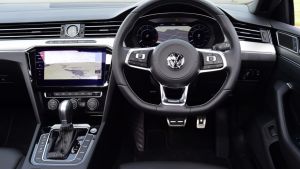
Used Volkswagen Arteon - dash
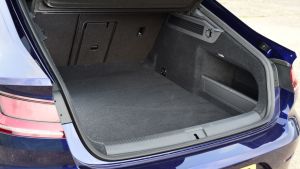
Used Volkswagen Arteon - boot
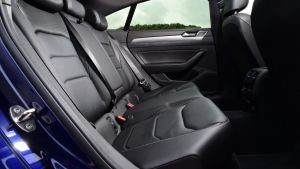
Used Volkswagen Arteon - rear seats
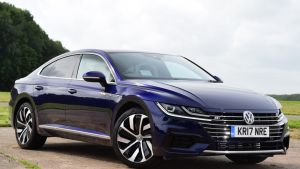
Used Volkswagen Arteon - front
Move up to Elegance and you’ll also get Nappa leather trim, heated and electrically adjustable front seats, Dynamic Chassis Control, an active cornering function for the headlights, plus a 9.2-inch touchscreen. The R-Line gets 19-inch alloys, along with sportier detailing inside and out.
The closest rival is the Audi A5 Sportback, which is related to the VW and shares some engines and transmissions. The Audi has an even more luxurious interior, and it’s crammed with additional technology, but it costs more to buy; there’s also a 3.0 TDI option if you want huge pace without excessive fuel costs.
Another Arteon rival is the BMW 4 Series Gran Coupé, which is a similar size and has hatchback practicality, clean engines and is beautifully made, but you’ll pay more for it.
The Skoda Superb offers lots of cabin and boot space, hatchback or estate usability, tempting prices and huge amounts of kit, or you could buy a high-spec Passat, which is similar to the Arteon but lacks its hatchback.
Efficient
To help cut fuel consumption when cruising, the 1.5-litre TSI petrol engine was fitted with Active Cylinder Technology.
Upgraded
Buy a post-October 2019 Arteon and it’ll come with a far better infotainment and digital dash display than older examples.
Full-size spare
All Arteons come with a spare wheel, and it’s not just a space-saver: you actually get a full-sized alloy in the boot as standard.
Good to tow
The Arteon was the 2019 Tow Car of the Year; it can pull anywhere between 1,600kg and 2,200kg depending on the variant you purchase.
It’s generally good news because the Arteon is crammed with kit, and everything is laid out so you can find it. It’s all made to a superb standard, too, and the seats are comfortable.You could argue that the Arteon lacks a little design flair, but there’s acres of space, with ample head and legroom in the back, and lots of cubby holes throughout.

Used Volkswagen Arteon - front tracking

Used Volkswagen Arteon - rear tracking

Used Volkswagen Arteon - rear

Used Volkswagen Arteon - front lights

Used Volkswagen Arteon - dash

Used Volkswagen Arteon - boot

Used Volkswagen Arteon - rear seats

Used Volkswagen Arteon - front
The Arteon’s boot can stow a huge 563 litres, or 1,557 with the back seats folded down. The Shooting Brake extends this to 590/1,600 litres.
The standard infotainment system includes sat-nav, DAB radio, Bluetooth and an eight-speaker stereo. An upgraded 9.2-inch unit and a premium stereo were also available.
Arteon owners can choose between fixed or flexible servicing regimes. The former is set at every 12 months or 9,300 miles, while the latter is up to two years or 18,600 miles. The first two fixed (annual) services are priced at £224 (which is an oil change only) and £374, while the first flexible service costs £270.
After this all Arteons are eligible for fixed-price menu servicing, and these alternate between minor and major at £184 and £354. The use of long-life coolant means it never needs to be replaced as such, but fresh brake fluid is needed after three years and then every other year, at £69.
The diesels have a cambelt that should be replaced every 130,000 miles on TDI units or 74,000 miles on BiTDI powerplants; dealers charge £494 to do this. The 1.5 TSI engine has a cambelt too, but unusually it’s designed to never be replaced.
The Volkswagen Arteon has been recalled five times so far in its life, the first time in a November 2017 campaign, which was the result of some cars built in August 2017 being manufactured with poorly cast rear wheel-bearing housings in place.
A handful of Arteons built up to May 2017 were recalled in March 2019 because of poorly bonded sunroof surrounds; five months later some Arteons were recalled in order to receive an engine software update.
Selected Arteons made between May and July 2019 were recalled in March 2020 because of incorrectly assembled brake pedals, then the most recent campaign was launched in April 2021 because some Arteons made between December 2020 and February 2021 had incorrectly assembled electrics.
The Arteon hasn’t appeared in our new or used Driver Power surveys because it doesn’t sell in big enough quantities, but VW does of course appear in our Brands survey. In the most recent one, in 2020, VW came 19th out of 30 firms, the highlights being practicality, fuel economy, connectivity and infotainment. Across VW’s model range, owners aren’t so keen on the engines, dynamics, or the servicing costs.
Sometimes the Arteon is dismissed as ‘a posh Passat’, but Volkswagen’s perennially popular saloon is a good base to build on. The Passat is roomy, well made and well equipped, and comes with excellent engines and transmissions, while the Arteon adds extra equipment, a more luxurious cabin and increased practicality. Volkswagen has never been afraid to charge top dollar for its products, but with the Arteon pitched against rivals from BMW and Mercedes, VW has had to increase the car’s value for money significantly, cramming this luxurious hatch with kit and designing it to stand out from the crowd. The result is a car that offers style, comfort, effortless cruising and reasonable running costs in one relatively affordable package. What more could you want?
Continue reading...
In the intervening years things changed somewhat, reaching their zenith with the Phaeton’s introduction in 2002, although sales were slower than VW wanted.
The company’s ambitions shrank a little after that with the introduction of the Passat-based CC saloon, which in 2017 was superseded by the more practical Arteon hatchback. This struck a neat balance between practicality, luxury and affordability.
Models covered
- Volkswagen Arteon Mk1 (2017-date) - Sleek-looking executive hatch delivers loads of style and standard equipment
History
The Arteon hit UK roads in September 2017, priced from £34,305 and with a choice of 187bhp 2.0 TSI petrol or 2.0 TDI diesel engines. The latter came in 148bhp and 237bhp forms, the more powerful only with 4Motion (four-wheel drive) and DSG.
A 148bhp 1.5 TSI arrived three months later, then a 268bhp 2.0 TSI was added in December 2018, in DSG guise only.
Only a five-door hatchback body was offered and buyers could choose Elegance or R-Line trims; an SE was added in July 2019.
The Arteon range was expanded in October 2020 when a Shooting Brake (estate) body joined the hatchback, and at the same time the SE trim level became SE Nav. Just a few months later in January 2021 a plug-in hybrid joined the line-up.
Which one should I buy?
There are no poor engine or transmission choices when buying an Arteon; all of them offer a decent balance of performance, refinement and economy. Everyday running costs for the 2.0 TSI are higher thanks to its greater thirst, but that’s the trade-off for having stronger performance.
All Arteons are generously equipped, with the entry-level SE featuring 18-inch alloy wheels, LED headlights, privacy glass, an eight-inch touchscreen with navigation, DAB radio, adaptive cruise control, three-zone climate control, automatic headlights and wipers, plus a heated windscreen along with front and rear parking sensors.

Used Volkswagen Arteon - front tracking

Used Volkswagen Arteon - rear tracking

Used Volkswagen Arteon - rear

Used Volkswagen Arteon - front lights

Used Volkswagen Arteon - dash

Used Volkswagen Arteon - boot

Used Volkswagen Arteon - rear seats

Used Volkswagen Arteon - front
Move up to Elegance and you’ll also get Nappa leather trim, heated and electrically adjustable front seats, Dynamic Chassis Control, an active cornering function for the headlights, plus a 9.2-inch touchscreen. The R-Line gets 19-inch alloys, along with sportier detailing inside and out.
Alternatives to the Volkswagen Arteon
The closest rival is the Audi A5 Sportback, which is related to the VW and shares some engines and transmissions. The Audi has an even more luxurious interior, and it’s crammed with additional technology, but it costs more to buy; there’s also a 3.0 TDI option if you want huge pace without excessive fuel costs.
Another Arteon rival is the BMW 4 Series Gran Coupé, which is a similar size and has hatchback practicality, clean engines and is beautifully made, but you’ll pay more for it.
The Skoda Superb offers lots of cabin and boot space, hatchback or estate usability, tempting prices and huge amounts of kit, or you could buy a high-spec Passat, which is similar to the Arteon but lacks its hatchback.
What to look for
Efficient
To help cut fuel consumption when cruising, the 1.5-litre TSI petrol engine was fitted with Active Cylinder Technology.
Upgraded
Buy a post-October 2019 Arteon and it’ll come with a far better infotainment and digital dash display than older examples.
Full-size spare
All Arteons come with a spare wheel, and it’s not just a space-saver: you actually get a full-sized alloy in the boot as standard.
Good to tow
The Arteon was the 2019 Tow Car of the Year; it can pull anywhere between 1,600kg and 2,200kg depending on the variant you purchase.
Interior
It’s generally good news because the Arteon is crammed with kit, and everything is laid out so you can find it. It’s all made to a superb standard, too, and the seats are comfortable.You could argue that the Arteon lacks a little design flair, but there’s acres of space, with ample head and legroom in the back, and lots of cubby holes throughout.

Used Volkswagen Arteon - front tracking

Used Volkswagen Arteon - rear tracking

Used Volkswagen Arteon - rear

Used Volkswagen Arteon - front lights

Used Volkswagen Arteon - dash

Used Volkswagen Arteon - boot

Used Volkswagen Arteon - rear seats

Used Volkswagen Arteon - front
The Arteon’s boot can stow a huge 563 litres, or 1,557 with the back seats folded down. The Shooting Brake extends this to 590/1,600 litres.
The standard infotainment system includes sat-nav, DAB radio, Bluetooth and an eight-speaker stereo. An upgraded 9.2-inch unit and a premium stereo were also available.
Prices
Running costs
Arteon owners can choose between fixed or flexible servicing regimes. The former is set at every 12 months or 9,300 miles, while the latter is up to two years or 18,600 miles. The first two fixed (annual) services are priced at £224 (which is an oil change only) and £374, while the first flexible service costs £270.
After this all Arteons are eligible for fixed-price menu servicing, and these alternate between minor and major at £184 and £354. The use of long-life coolant means it never needs to be replaced as such, but fresh brake fluid is needed after three years and then every other year, at £69.
The diesels have a cambelt that should be replaced every 130,000 miles on TDI units or 74,000 miles on BiTDI powerplants; dealers charge £494 to do this. The 1.5 TSI engine has a cambelt too, but unusually it’s designed to never be replaced.
Recalls
The Volkswagen Arteon has been recalled five times so far in its life, the first time in a November 2017 campaign, which was the result of some cars built in August 2017 being manufactured with poorly cast rear wheel-bearing housings in place.
A handful of Arteons built up to May 2017 were recalled in March 2019 because of poorly bonded sunroof surrounds; five months later some Arteons were recalled in order to receive an engine software update.
Selected Arteons made between May and July 2019 were recalled in March 2020 because of incorrectly assembled brake pedals, then the most recent campaign was launched in April 2021 because some Arteons made between December 2020 and February 2021 had incorrectly assembled electrics.
Driver Power owner satisfaction
The Arteon hasn’t appeared in our new or used Driver Power surveys because it doesn’t sell in big enough quantities, but VW does of course appear in our Brands survey. In the most recent one, in 2020, VW came 19th out of 30 firms, the highlights being practicality, fuel economy, connectivity and infotainment. Across VW’s model range, owners aren’t so keen on the engines, dynamics, or the servicing costs.
Verdict
Sometimes the Arteon is dismissed as ‘a posh Passat’, but Volkswagen’s perennially popular saloon is a good base to build on. The Passat is roomy, well made and well equipped, and comes with excellent engines and transmissions, while the Arteon adds extra equipment, a more luxurious cabin and increased practicality. Volkswagen has never been afraid to charge top dollar for its products, but with the Arteon pitched against rivals from BMW and Mercedes, VW has had to increase the car’s value for money significantly, cramming this luxurious hatch with kit and designing it to stand out from the crowd. The result is a car that offers style, comfort, effortless cruising and reasonable running costs in one relatively affordable package. What more could you want?
Continue reading...
